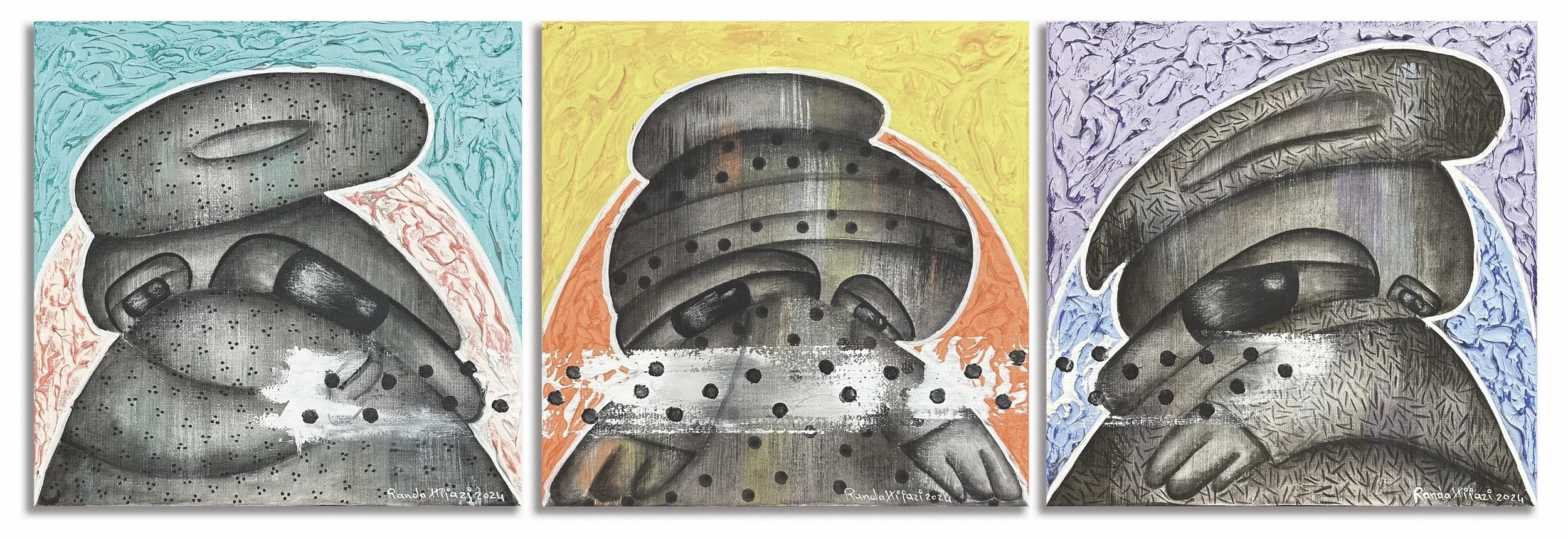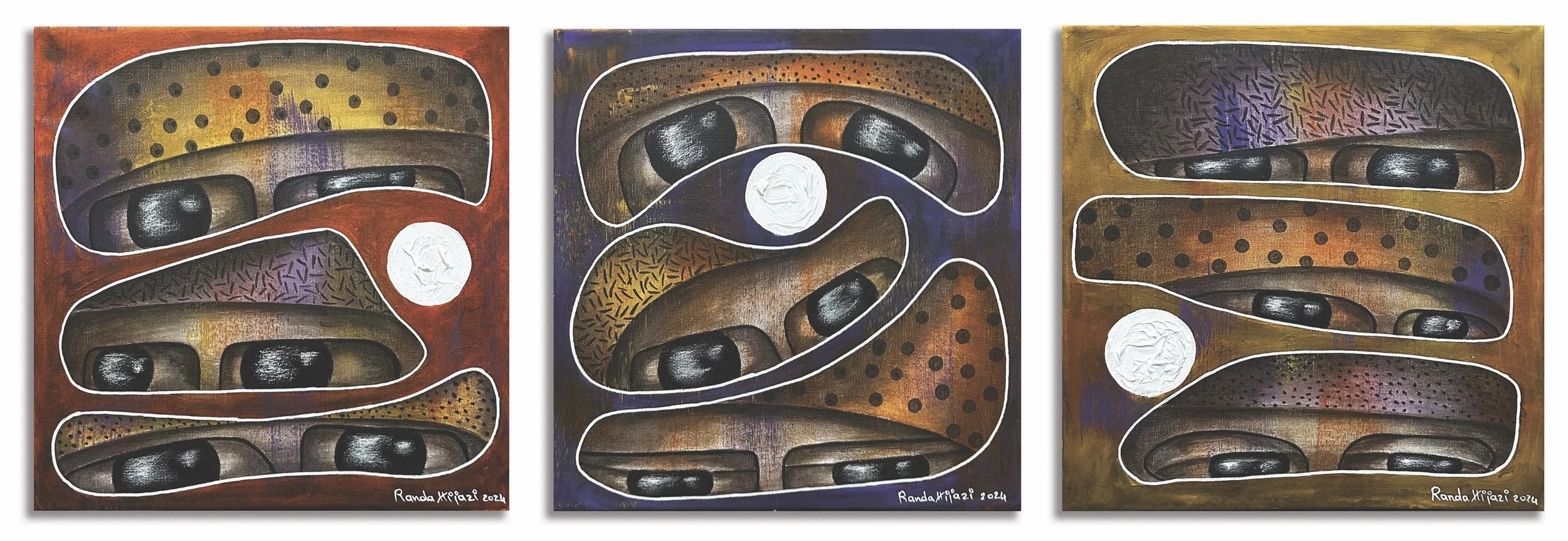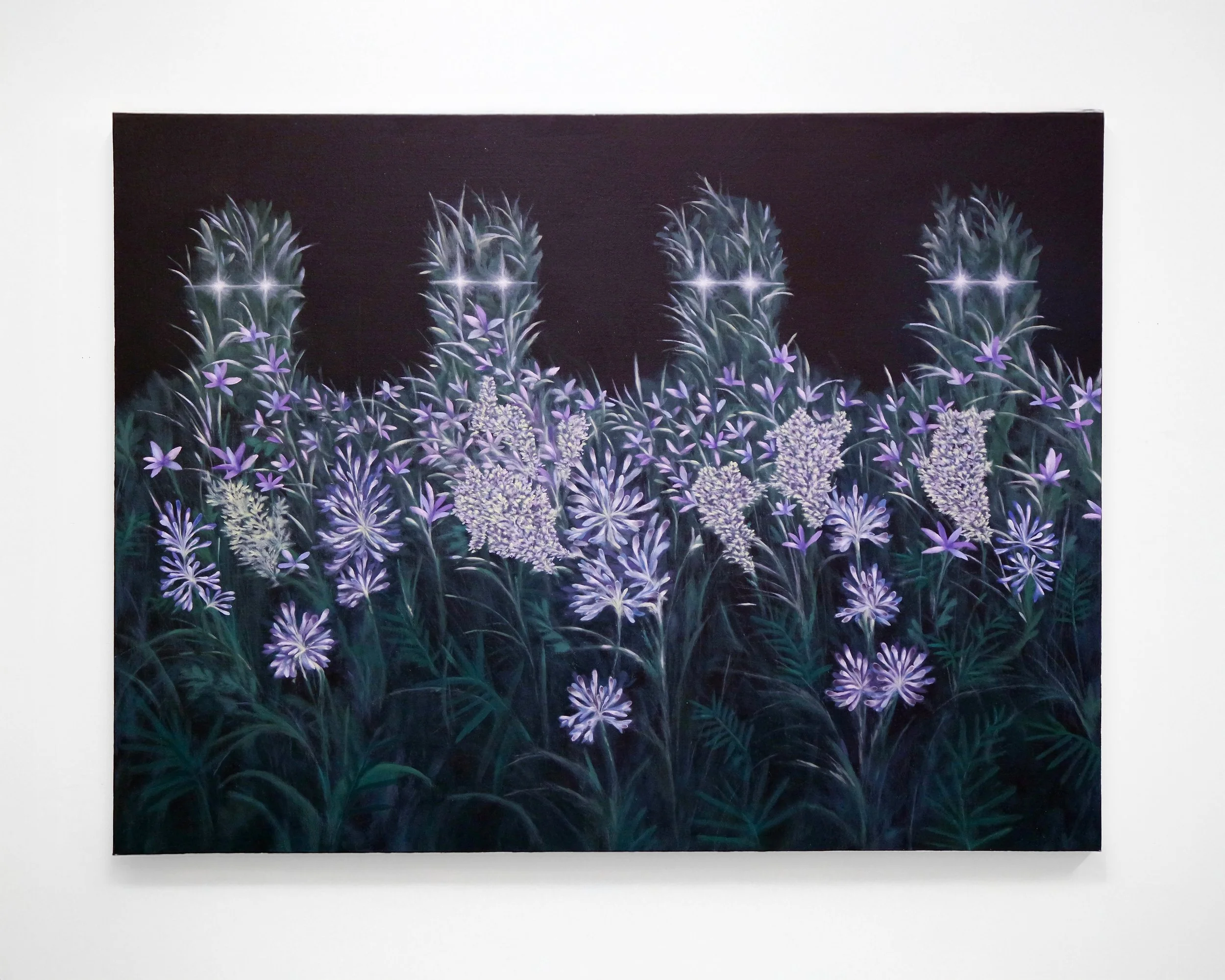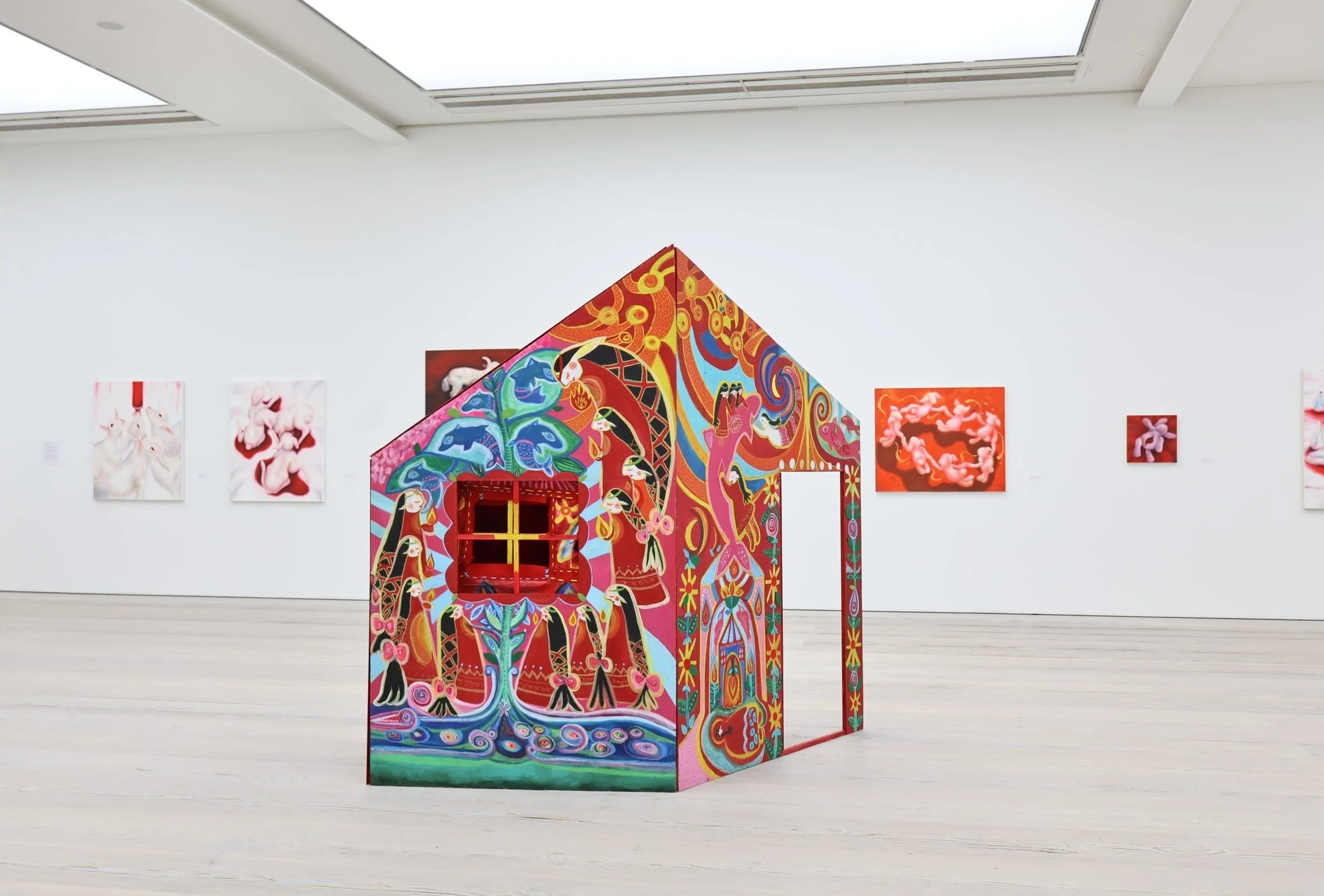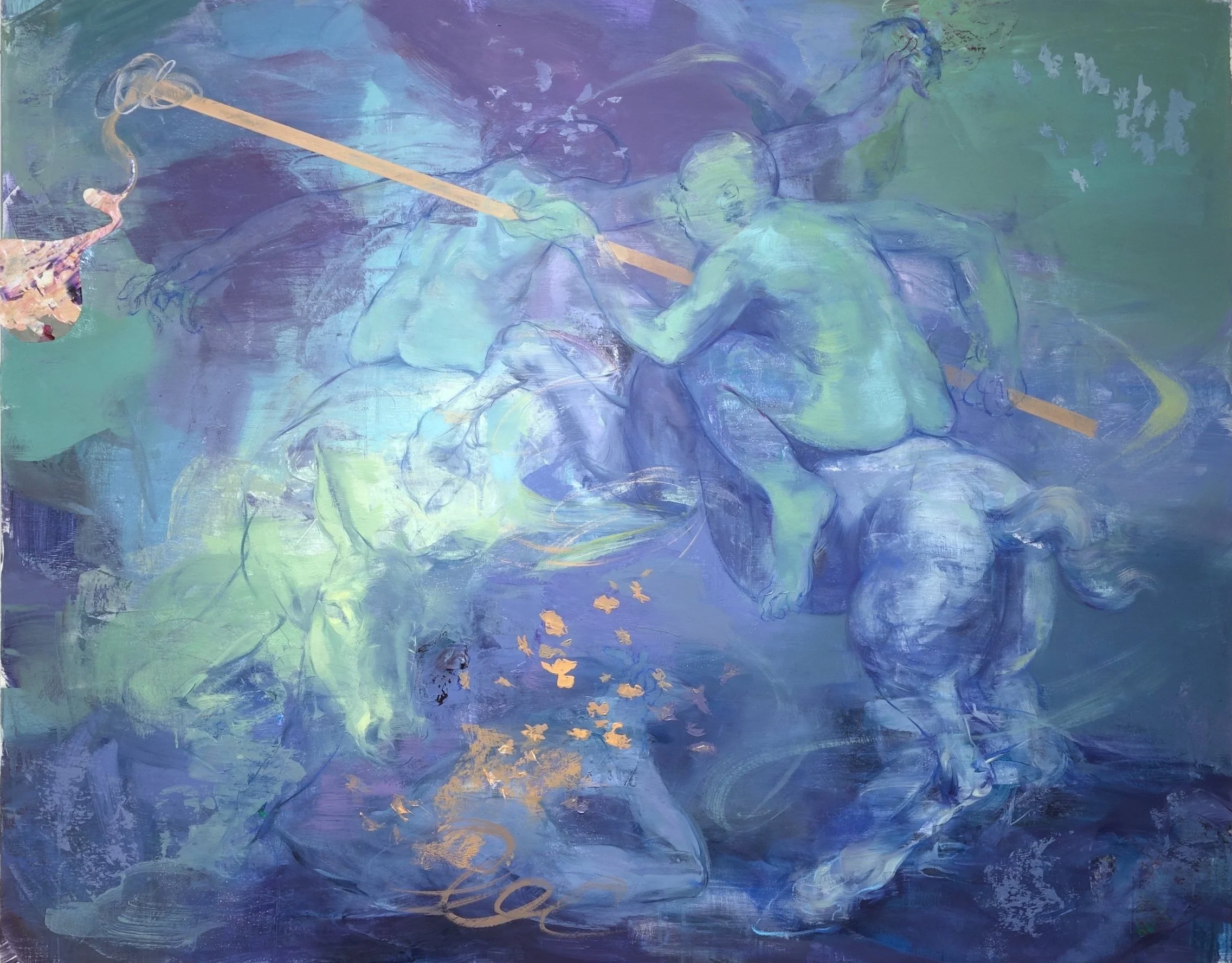10 Questions with Randa Hejazi
Randa Hejazi is a Syrian-Canadian contemporary visual artist currently based in Laval, Quebec. Born in Damascus, Syria, she studied Fine Arts (2000) and Journalism & Media Sciences (2008) at the University of Damascus. Her dual academic background enables her to merge artistic expression with a journalistic eye, addressing social and humanitarian issues such as war, poverty, and injustice. After moving to Dubai, Randa Hejazi relocated to Canada in 2017, earning a diploma in Business Administration in Montreal in 2019 to enhance the professional management of her art career.
Her early work combined Impressionism and Realism, but she recently embraced Surrealism through her ongoing series Human Threads, focusing on shared human experiences and cultural narratives. Her art reflects her journey across three cultures, Syrian, Emirati, and Canadian, blending deep Eastern roots with Western influences to create a unique artistic voice.
Randa Hejazi had exhibited her work globally, in Syria, Lebanon, UAE, France, and Canada, and had received critical acclaim and several prestigious awards. She is an active member of local and international art associations, including RAAV, Culture Laval, and the Canada Council for the Arts. Through her art, she continues to promote cultural dialogue, preserve heritage, and inspire empathy across borders.
Randa Hejazi - Portrait
ARTIST STATEMENT
Randa Hejazi's work explores the human condition and aims to shed light on issues such as poverty, war, and social injustice, while also preserving the collective memory of civilisations. With academic backgrounds in Fine Arts and Journalism from the University of Damascus, she merges artistic sensitivity with a journalistic eye to tell stories that resonate across cultures.
Her artistic journey, spanning Damascus, Dubai, and now Canada, has shaped a visual language that bridges East and West. This evolution is reflected in her recent shift toward a surrealist style in her series Human Threads, where she explores the emotional threads that bind humanity.
In this spirit, Randa Hejazi created Timeless Tales: Artistic Narratives of Canada's Rich Heritage, a large-scale mural celebrating Canada's diverse history and multicultural identity. The work highlights key moments and figures from Canadian heritage, woven together through symbolism and vibrant storytelling. It reflects the artist's belief that art is both a mirror of society and a force for unity.
In 2024, one of her works was selected as the official greeting card image for the Canadian government, a meaningful recognition of her commitment to using art as a bridge between people and cultures.
Timeless Tales, 2024 © Randa Hejazi
INTERVIEW
First of all, what sparked your interest in art, and how did you discover your passion for painting?
I often say that the paintbrush and I were born from the same womb, because I truly don’t remember when my passion for art began; it feels as though it has always been a part of me. Art has accompanied me since my earliest childhood; it lived within me before I even understood it. It was my way of seeing the world and expressing myself in a language that felt entirely my own. I believe that art is not something we learn with time; it is an innate gift, a unique sense embedded in the soul. That’s why I often say artists are born, not made. They are born with a sensitivity that allows them to see beauty in the smallest of things.
I was born and raised in Damascus, a city that, at the time, pulsed with life, creativity, and culture. It was full of colour, music, and human stories. Before the war cast its heavy shadow, Damascus was a city that inspired the soul. As the oldest continuously inhabited city in human history, its ancient heart, Old Damascus, played a powerful role in shaping my visual and artistic identity. Its history, architecture, and artistic legacy, which stretch back through countless civilisations, were like a living museum that surrounded me every day. I am a daughter of Old Damascus. I grew up walking its narrow alleys, touching its ancient walls, and listening to the stories whispered by its castles and arches. I absorbed its spirit not just through books, but from its very stones. And perhaps that’s why art, for me, became a way to carry forward those stories, an attempt to preserve the memory of a place that conflict has slowly tried to erase.
Could you tell us how your journey from Damascus to Dubai and now Canada has shaped your artistic voice? And how has living in three very different cultural contexts influenced the themes you explore?
My journey from Damascus to Dubai, and now to Canada, has been far more than a geographical relocation; it has been a profound internal transformation and a deeply human experience that shaped my artistic identity and altered my worldview.
In Damascus, I was born into the embrace of history, growing up surrounded by ancient architecture, handcrafted artistry, and bustling markets full of life. I absorbed the visual and symbolic richness of an environment steeped in identity and meaning. Art was intrinsically linked to heritage, memory, and stories passed down through generations. This rooted foundation was the first lens through which I saw the world as an artist.
Then came Dubai, where I witnessed rapid modernisation and immense cultural shifts. The city pulsated with diversity and openness, showing me how art can thrive in a dynamic, globalised context. Dubai encouraged me to expand my tools and break from traditional frameworks, prompting me to explore contemporary themes and rethink the relationship between art and identity within a constantly evolving space.
Canada, in turn, offered me a place for reflection and a nurturing environment that fosters free expression and openness to others. In this peaceful country, I was able to listen more deeply to my inner voice and weave together my Eastern roots with the new spirit I found in exile. The themes I explore grew more humanistic and contemplative, focusing on identity, displacement, belonging, roots, and integration.
As any artist would know, reading a new book is like nourishment that opens doors to unforeseen imaginations; how much deeper then is the impact of living a real human experience with all its joys and hardships? Moving between diverse cultures, though challenging, carried within it countless blessings I did not fully appreciate at the time. Over the years, my perspective on life and humanity has shifted profoundly. I came to understand the true meaning of our human differences, recognising them as a genuine blessing for anyone who embraces them, especially an artist. I cannot fully describe the deep spiritual growth I have gained from every moment I have lived, whether joyful or sorrowful, easy or difficult, over the past years. This depth has brought me greater awareness, acceptance of others, and genuine awe at life’s complexities and contradictions. All of this has deeply influenced my subjects, interests, and artistic style.
Living across three distinct cultural landscapes has granted me the ability to see the world from multiple perspectives. This journey has blended my artistic style between East and West, symbolism and impression, nostalgia and reality. I have learned that art does not belong to a single place; at its core, it is an honest reflection of the human journey and its transformations.
How does your background in journalism influence the stories you choose to tell through your art?
My background in journalism has had a profound impact on my artistic practice. It taught me how to observe the world critically, to notice the subtle human details that often go unnoticed, and to approach every subject with depth and responsibility. After studying journalism, I began to see art as a two-part process. The first part is theoretical: I dive into the subject, studying it from all angles, social, psychological, historical, through in-depth reading and research. The second part is the creative execution, which only comes after I’ve absorbed enough understanding to express the topic meaningfully. I’ve come to believe that art requires knowledge before inspiration; even the simplest idea demands depth. Since most of my themes are humanitarian or cultural, I treat each one with care. For example, when working on the subject of childhood cancer, I don’t begin painting until I’ve read extensively, medically, psychologically, and emotionally, about its effects on both the child and their family. This approach, which journalism taught me, adds depth and clarity to my work.
In the end, I look at art through the eyes and mind of a journalist, but I create it with the heart and soul of an artist. That balance has brought me greater satisfaction and a deeper connection to the stories I choose to tell.
From the cave of Qatar, 2018 © Randa Hejazi
History Journey, 2018 © Randa Hejazi
Your work often highlights social and humanitarian issues, as you mention in your statement. Why is this important to you as an artist?
For me, art is not merely a pursuit of beauty; it is a message and a human responsibility. Social and humanitarian issues lie at the heart of my work because they touch the essence of human dignity, pain, and resilience. I see art as a voice for those who have none, and as a means to awaken empathy and awareness. What deepened this commitment is my own experience with injustice, displacement, and war. I have personally lived the pain of being uprooted, of witnessing harm inflicted on innocent people caught in conflicts they never chose. These experiences left a lasting mark on me, making me emotionally bound to these themes, not out of distant sympathy, but from lived reality.
Over time, I found myself drawn to telling the stories of entire peoples, to exploring civilisations, and to warning through my art that when a homeland or culture is lost, so too is our humanity, our identity, and our collective memory.
That’s why I no longer seek to paint beauty just for the sake of beauty, or to produce works simply to decorate walls.What matters most to me is that each painting carries a message, perhaps even a cry from the heart. That is what fulfils me as a human being and gives true meaning to my role as an artist.
What inspired your shift from Impressionism and Realism to a more surrealist style in your series Human Threads?
The shift from realism and impressionism to surrealism was not a conscious or deliberate decision. It was the result of a profound shock and near-complete destruction of my life and memory, a personal revolution against what I had lived and refused to accept. These were moments filled with pain beyond description or imagination. After being away from Syria for eleven years without visiting Damascus even once, I woke up one day to the news of my father’s death. He had remained in Damascus despite all the dangers and refused to leave. At that moment, I decided to travel to Damascus to attend his funeral. My relationship with him was deeply spiritual and profound, and his loss was an irreparable fracture in my life.
I travelled carrying a heavy burden of grief, but the shock was compounded when I saw Damascus for the first time in years. I realised I had lost not only my father but also my homeland, my identity, my past, and my memories. I saw Damascus as I had never seen it before, destroyed and overwhelmed by sorrow, death, and poverty. A city once full of life had become a grey, lifeless mass. After the funeral, I returned to Canada utterly stripped of any sense of the past, family, or life itself, and this devastation overwhelmed me mentally and emotionally. During that period, I was unable to paint; I only felt anger, sorrow, and rebellion against all my losses.
This overwhelming pain led to a refusal to accept the reality that had invaded my life. Despite all my efforts to resist it, I could not. The result manifested itself unknowingly in my series “Human Threads,” where my drawings became fantastical and surreal, disconnected from reality. The figures have no mouths because they have nothing to say that could express the depth of their sorrow, only eyes, expressions, and lines. I began to embody the hidden connections that bind us as human beings: psychological ties, intertwined emotions, inner contradictions, and the continuous search for self. Surrealism gave me a way to triumph over my grief and a temporary escape from a reality I rejected. It allowed me to manipulate symbols, metaphors, and time. I was no longer bound by form or reality but created worlds blending dream and truth, memory and imagination, to depict the complex human conditions we all experience.
This series was an unconscious outpouring beyond my control of my feelings and anger. I do not know whether I will continue with this style or return to the impressionism I practised before. Since an artist is influenced by their surroundings and inner worlds, I will leave it to time to determine the place and boundaries of my work.
In your mural Timeless Tales, you celebrate Canada’s heritage. What message did you hope to share through this piece?
I would like to emphasise once again that I do not work on any piece unless it has a deep impact on my humanity and soul. The painting “Canada” was, for me, a form of compensation for a lost identity, a long journey in search of a new self, or at least an attempt to merge my previous identity with that of this new country that hosted me, loved me, and that I have come to love in return. I began working on this mural during the same period when I was studying for my Canadian citizenship. When I read a brief history of Canada, I was overcome by a profound feeling that a new opportunity was being granted to me to integrate into a venerable and multicultural country like Canada. This feeling pushed me to delve deeper into Canadian history books, and I decided to create this mural on a scale that matched my urgent need for belonging.
I painted every part of it with deep love and intensive knowledge of the country’s history and culture. As I mentioned in the promotional video titled “Identity,” I lived the life of each character depicted and imagined myself in their place to such an extent that I felt an indescribable sense of belonging. The result was a large mural titled “Timeless Tales: Artistic Narratives of Canada’s Rich Heritage,” which depicts Canada’s long history from its discovery up to the present day. This mural proudly features as many prominent historical Canadian figures as possible, including personalities from Indigenous peoples, French settlers, and British colonists, in a way that honours their rich history and unique contributions.
The mural highlights heroes, leaders, artists, scientists, and athletes who have played vital roles in building Canada over the centuries. These figures, coming from diverse cultural backgrounds, are united in time and place to embody their shared goals of building and advancing Canada. Measuring 900 × 450 cm, the mural is an oil painting on canvas that has not yet been exhibited. I hope this work will receive the recognition it deserves from relevant institutions, whether governmental, museums, or cultural organisations.
This project represents a significant achievement in my artistic career and embodies my deep commitment to documenting the history and shared values of nations, passing them on to future generations through the language of art.
How do you see your art building a bridge between Eastern and Western cultures?
I see my art as a bridge connecting two rich and profound cultures, the East and the West, through a visual language that unites and celebrates their intersection. Having grown up in an Eastern environment and now living in a Western society, I’ve developed a deep understanding of both worlds, with all the history, values, and aesthetic and spiritual depth each holds. Art, for me, is the medium that allows me to harmoniously blend these elements, creating works that reflect a multi-dimensional identity, one that embraces Eastern heritage while engaging with the freedom and experimental spirit of contemporary Western art. I incorporate symbols, colours, and techniques rooted in Eastern traditions and weave them into the dynamic and evolving language of the West. And I will continue to pursue themes that shed light on our shared humanity and common concerns, regardless of race, colour, religion, or belief. I believe art has the power to foster love and a sense of collective belonging, and to present these values as essential to humanity as a whole.
I also strive to introduce Western audiences to the depth and richness of Arab civilisations, something I explored in my exhibition “22 Kisses,” where I highlighted the heritage and history of 22 Arab nations. At the same time, I share with my Eastern community the beauty, openness, and cultural sophistication I’ve experienced in Western societies. Through this ongoing dialogue, I hope to make humanity itself the key to narrowing cultural gaps and bringing diverse civilisations and peoples closer together.
© Randa Hejazi
© Randa Hejazi
What role does symbolism play in your art, and how do you choose the symbols you use?
Symbolism in my art is not merely decorative or an additional visual element; it is a parallel language to words. I use it to express ideas and emotions that are often too complex or delicate to be stated outright. For me, art is not only what is seen, but also what is felt and read between the lines and colours. That’s why I choose my symbols with great care; they often reflect an emotional state, a lived philosophy, or a human issue I’m addressing. I don’t deliberately search for ready-made symbols; rather, the concept and content of the work naturally guide me toward the appropriate symbol. Sometimes the symbolism comes from my Eastern heritage, and other times from my contemporary experiences in the West.
For instance, in my Human Threads series, I used “threads” as an indirect symbol of human connection, those invisible, fragile, or strong ties that bind us together. The absence of mouths in some figures symbolised silenced voices or the inability to express oneself in moments of pain or alienation.
For me, a symbol is never an end in itself, but a means, a door that opens reflection and interpretation for the viewer. I want those who see my work to feel free to read it through their own lens, and perhaps even find a piece of themselves within it.
Looking ahead, is there anything else you would like to experiment with, both technically and thematically?
For me, art is a continuous journey of discovery and experimentation. I do not believe in staying fixed in one style or theme. On the contrary, every stage of my life opens new doors for expression and pushes me to explore different tools and techniques that reflect my evolving emotional and intellectual states. Technically, I’m interested in exploring new artistic methods such as printmaking, incorporating three-dimensional elements into the canvas, and even integrating sound or poetic texts into some works, to create a deeper sensory experience for the viewer.
As for themes, I have long been committed to addressing core human issues, particularly those related to women, childhood, war, famine, and illness. I’ve also maintained a deep interest in the civilisations and cultures of various peoples. Today, I find myself immersed in a new surrealist experience, through which I explore more psychological dimensions of the human being, examining internal contradictions, emotional entanglements, and our eternal search for peace and balance. And because I am an artist who is deeply affected by the issues and realities of life, I tend to approach my subjects in a spontaneous, intuitive way. I don’t always plan my themes in advance. Instead, a powerful emotional reaction to an event or human condition often leads me to research, reflect, and create. So I leave my future topics open to whatever reality may impose, trusting that true art is not carefully predesigned, but rather born from the moment and from the human condition itself. At the same time, I remain devoted to my central mission: to use art as a means to document civilisations, bring cultures closer together, and build a visual memory of our shared human identity.
Finally, what are you currently working on, and what new ideas are you excited to explore next?
At this stage, I continue to work within my surrealist experience, which has allowed me to explore new psychological dimensions of artistic expression. I am further developing this journey by delving into symbols and the emotional layers tied to memory, loss, identity, and the invisible threads that connect us as human beings. One of the projects I am currently working on is a series of paintings that highlight the civilisation and culture of the Kingdom of Saudi Arabia, a nation that has truly amazed me with its rapid transformation and conscious rise beyond a past that no longer reflects the aspirations of its people. The cultural, intellectual, and developmental openness that Saudi Arabia is experiencing today has been a source of great inspiration and joy for me. It is a hopeful example that when people are led with vision and determination, they can elevate their nations and take their place in the future. This powerful shift deeply moved me, and I felt an artistic responsibility to document this historic moment through my work. At the same time, I look to the future as an artist who places no boundaries on her exploration. There are many themes that interest me and that I hope to explore, such as the impact of technology on humanity, digital isolation, and identity in the age of artificial intelligence. But I believe that every idea arrives in its own time, when I am emotionally and artistically ready to receive and express it.
So I continue observing, reflecting, reading, and allowing myself to be moved, to feel, to question, and to translate all that into a visual language that is sincere, close to the viewer, and deep in its expression of our shared humanity.
In conclusion, I would like to say: Today, as I continue my artistic journey, I feel deep gratitude for every experience that has shaped me, and I carry a strong passion to explore new horizons that unite my roots with my evolving identity. I dream that my paintings and ideas reach those who understand and appreciate them, for art without resonance in the hearts remains a lost cry unheard.
Artist’s Talk
Al-Tiba9 Interviews is a promotional platform for artists to articulate their vision and engage them with our diverse readership through a published art dialogue. The artists are interviewed by Mohamed Benhadj, the founder & curator of Al-Tiba9, to highlight their artistic careers and introduce them to the international contemporary art scene across our vast network of museums, galleries, art professionals, art dealers, collectors, and art lovers across the globe.





